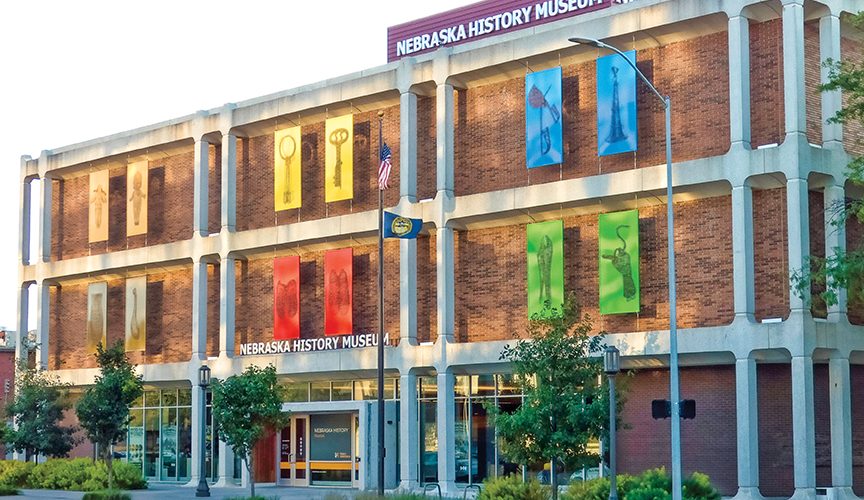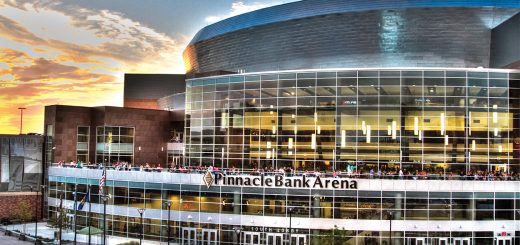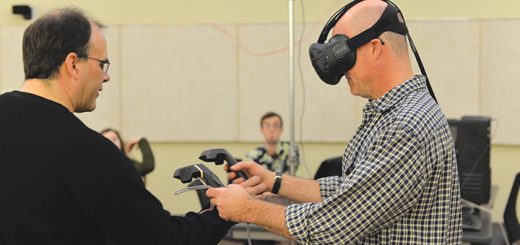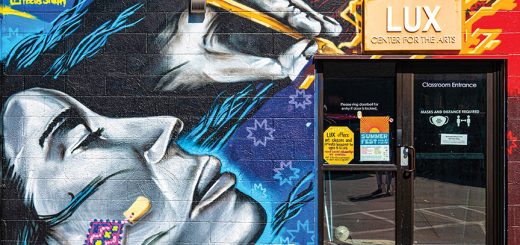Lincoln Museums—art, science, history and fun

If art’s your thing, Lincoln’s got plenty of art museums, showcasing sculptures, paintings, quilts and more. If you’re a history buff, Nebraska’s capital city offers a museum that traces 10,000 years of elephant-type beasts that once roamed here—and another that showcases the rich history of Native Americans that goes back as far.
So if you’re looking for architectural tours, nature centers, gardens or parks, Lincoln has lots to offer both kids and adults. Here are a few sights worthy of a visit.
University of Nebraska State Museum at Morrill Hall
A top-notch natural history museum, the University of Nebraska State Museum is on the University of Nebraska-Lincoln’s City Campus at 14th and Vine streets. Archie, a 5,000-pound, life-sized bronze replica of the Archidiskidon imperator maibeni, greets visits at the door leading into Morrill Hall. Archie was installed in 2006 as a tribute to the museum’s Elephant Hall, housing the world’s premier collection of preserved mammoth, mastodon and four-tusker skeletons and tracing the 10,000-year history of elephant forebears once found in the central United States. Murals by Mark Marcuson highlight this collection.
The Tree of Life, one of several interactive exhibits at the museum, illustrates 3.5 billion years of earth’s evolutionary history. With the swipe of a fingertip, users can travel through the phylogenetic tree to understand how all life on earth shares common ancestry.
The Hall of Nebraska Wildlife features 16 dioramas and interactive exhibits providing a look into the sights and sounds of Nebraska wildlife from meadowlarks to bison. Other permanent exhibits include the First Peoples of the Plains, which looks at cultural traditions past and present. Weapons Throughout Time illustrates the development of hunting, fighting and ceremonial weapons, and the Mesozoic Gallery explores the Age of Dinosaurs, featuring Nebraska fossils of ancient sea giants. Interactive exhibits allow visitors to enter a dig site and experience the processes of paleontology.
And, after being closed to the public for more than 50 years, the museum’s fourth floor level has been transformed into state-of-the-art exhibits using modern technology. Celebrate Nebraska’s natural heritage, and travel through time and space to learn how the state’s birds, plants and animals are shaped by geological changes and human beings.
Every third Sunday, Sunday with a Scientist brings a different, family-friendlty topic to Morrill Hall. Kids can see how fossils are unearthed and learn about the natural world with buffalo hide, feathers and other animal-related objects.
Also inside the museum, Mueller Planetarium’s multimedia shows make use of a full-dome projection system to offer shows for all ages, allowing visitors to immerse themselves in high-tech adventures in 360-degree space. The Planetarium was the seventh location in the world to adopt the Space Telescope Science Institute’s ViewSpace outreach program. As a direct computer link with STScI, the Planetarium was a pioneer in trial testing ViewSpace programming and its content. Visit www.museum.unl.edu. for hours and details.
Hyde Memorial Observatory
The observatory at Holmes Park in south Lincoln is dedicated to public education and viewing. Staffed by volunteers, Hyde Memorial Observatory is the only U.S. observatory built and furnished entirely by donations. Admission is free. Hyde is open every Saturday evening year-round and hosts astronomy presentations for visitors. The website provides information on weather conditions, upcoming sky events, and the current stars and planets in view. For seasonal times and program information about the observatory at 3701 S. 70th St., visit hydeobservatory.info.
Nebraska History Museum
Native Americans and explorers, fur-traders and homesteaders, farmers and patriots—all the Plains people—combine to tell the story of this land at the Nebraska History Museum at 131 Centennial Mall North on the southern edge of the University of Nebraska-Lincoln’s City Campus.
More than 125,000 objects and documents make up its ever-growing collection. The museum’s School Program offers lessons and fun for every age group, including Curiosity Labs and guides.
Visitors can examine historical documents, photographs, artifacts and learn the wisdom of elders. Past exhibits have included sod house portraits by Solomon Butcher and historic photographs.
And through January 2021, the museum will highlight the 100th anniversary of the 19th Amendment, which guaranteed women the right to vote. The exhibit looks back at Nebraska’s place in the history of women’s suffrage and features some of the women who broke barriers in the state.
Admission is free. Learn more at history.nebraska.gov/museum.
State Capitol
Designed by Bertram Goodhue, the “tower of the plains” was built over 10 years from 1922 to 1932. The 400-foot monolith is visible from far outside of Lincoln, and from countless points inside the city.
Topped by The Sower, a nearly 20-foot-tall bronze figure casting the seeds of life to the wind, the building is spectacular. The interior is rich in detailed motifs and employs an immense variety of materials—from mosaic and gold and richly colored tiles to solid walnut and myriad inlaid woods, carved limestone and painted murals. Laden with allegory and themes taken from agriculture, history and early people, it is recognized by architects as the nation’s first truly vernacular state capitol building. Free guided tours of the building at 1445 K St. begin each hour, 8-5 weekdays, 10-5 on Saturdays and 1-5 Sundays. Get more information at www.capitol.org.
Governor’s Residence
Just south of the state Capitol, at 1425 H St., the Nebraska governor’s residence is tucked behind a tall, wrought-iron fence and built in neoclassical brick. The modified Georgian Colonial was built in the 1950s and features mementos of governors past and a charming doll collection replicating Nebraska’s First Ladies in their inaugural gowns. For more information and to schedule guided tours, call 402-471-3466 or visit governor.nebraska.gov/governors-residence.
The Kennard House
Near the Nebraska State Capitol, the Thomas P. Kennard House is the oldest surviving building in the city of Lincoln. Built in the elaborate Italianate style in 1869, Nebraska’s first Secretary of State hoped its architecture would inspire faith in the new city. After its sale in 1887, the house at 1627 H St. served as a fraternity/sorority house, boarding house, private boys’ home and single-family residence. Its life as a museum began in 1965, when it was designated a Nebraska Statehood Memorial; it was listed on the National Register of Historic Places in 1969. Period furniture and mementos offer an interesting perspective on Nebraska’s history. Open by appointment only. More, visit history.nebraska.gov/visit/thomas-p-kennard-state-historic-site.
Museum of American Speed:
The Smith Collection
Called “the very best racing museum in the country,” by Automobile Magazine, the three-story museum at 599 Oakcreek Drive was founded in 1992 by “Speedy” Bill and Joyce Smith. Its collection is dedicated to preserving and interpreting the growth of racing and record-breaking speed engines that drove automotive history. The museum west of downtown Lincoln displays racing autos, but also traces the history of the innovative parts and elements of the fastest engines ever made. The unusual collection is the result of the Smiths’ six decades of personal passion for racing and hot rodding. The museum is open noon-4:30 p.m. Monday-Friday and 9 a.m.-1 p.m. Guided tours are offered weekdays. Admission is $15. For more information, see www.museumofamericanspeed.com.
William Jennings Bryan’s Home, Fairview
Built in the early 1900s on a hilltop that provided a “fair view” of the Capitol and surrounding farmland, this historic home is worth visiting. Former U.S. Secretary of State, two-term congressman and three-time Democratic presidential candidate William Jennings Bryan is best known for his hard-earned triumph over famed attorney Clarence Darrow as the prosecutor in the notorious Scopes’ Monkey Trial, which challenged a Tennessee law that forbade teaching evolution. Science lost. Bryan won, but died days later.
Now part of the Bryan East Campus of Bryan Medical, the house at 4900 Sumner St. has been restored to its early 1900s grandeur, and its lower-level museum offers historical recordings and exhibits.
Schedule tours at least 48 hours in advance at 402-481-3032.
National Museum of Roller Skating
Small but mighty, odd and charming, the National Museum of Roller Skating houses the largest collection of roller skates and roller skating memorabilia in the world, including a gas-powered skate. Featured in Smithsonian magazine as a unique tribute to roller sports, interactive exhibits include How to Build a Roller Skate and Evolution of the Wheel. The museum at 4730 South St. is open weekdays, 9-5. For more information, visit rollerskatingmuseum.org.
Lester F. Larsen Tractor Test
and Power Museum
The Tractor Test and Power Museum on the University of Nebraska-Lincoln’s East Campus is a must-see for agriculture buffs, engineers and future farmers. The museum is inside the first tractor test laboratory in the world, and tells the story of tractor testing in Nebraska, which continues to this day. The museum’s holdings include examples of tractors tested between 1919 and 1980, an original test car, a dynamometer and a children’s area that includes a large tractor cab for climbing. Tractor testing is unique to Nebraska, and the story the Larsen Tractor Test and Power Museum is unlike any other in the country. Visit tractormuseum.unl.edu for details, including GPS coordinates that tell you how to get there.
American Historical Society of Germans from Russia Museum
The American Historical Society of Germans from Russia Museum celebrates the 19th century immigration of Germans from Russia. Originally recruited from Germany with the promise of greater freedom, changes in politics and other hardships led the population to emigrate from Russia, settling in agricultural areas. Once here, they became an integral part of Lincoln’s community. As international headquarters for the Society of Germans from Russia, the museum at 631 D St. south of downtown includes a library, genealogical archives and special displays. Buildings within the city-block area are a part of the museum, including two houses furnished as common homes of early 1900s. Visit ahsgr.org for more information.
Lincoln Children’s Zoo
All aboooaaard! The perfect outing for the entire family, this beautifully landscaped zoo at 1222 S. 27th St. is home to more than 40 endangered animals, including the Humboldt penguin and snow leopard. Its mission is to offer children first-hand learning by interaction with living things, and to pursue saving endangered animals.
The variety of creatures in this user-friendly zoo includes white-handed gibbons, a fossa, dromedaries, a tree wallaby and many smaller mammals and reptiles. Close encounters are easy in the zoo’s butterfly house, accessible aviary and paths where peacocks roam the grounds. And a miniature train takes visitors through the grounds.
In 2019, the zoo became a year-round attraction with the addition of indoor space. Four new opportunities that came with the expansion include a giraffe feeding experience, an up-close tiger encounter, a plaza with a splash stream and an indoor treehouse where visitors can climb with spider monkeys. See more at lincolnzoo.org and visit the zoo for a train ride around the grounds.
Lincoln Children’s Museum
Often lauded as the best children’s museum in the Midwest, the Lincoln Children’s Museum offers exploration, sparks imagination and encourages discovery —but it’s mostly geared for play. Kids can become a newscaster, a veterinarian, firefighter, truck driver or grocer and explore aeronautics in a real plane or simulated spaceship, with uniforms and costumes provided.
A stage on the lower level of the museum at 1420 P St. has a makeup table, lights and curtain and costumes for budding performers. A huge water table and interactive hot air balloon fascinate young scientists, and a child-sized prairie dog village allows kids to explore animal life. A toddler area with toys is available for the littlest, and art activities are offered all day long. The three-floor museum is loads of fun for parents as well. Call 402-477-4000 or visit lincolnchildrensmuseum.org.
And you can read about the International Quilt Museum here.




Recent Comments